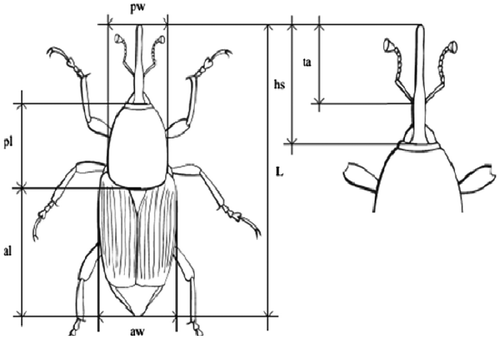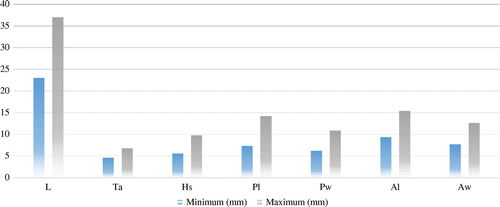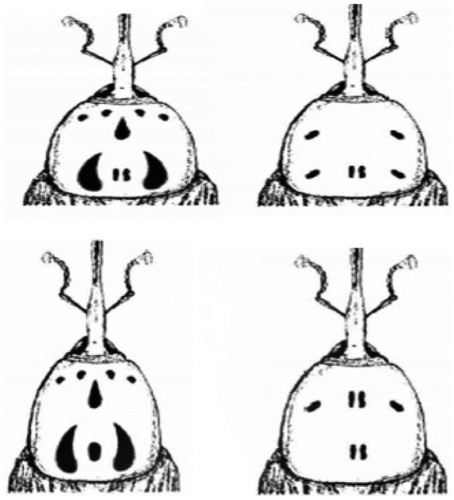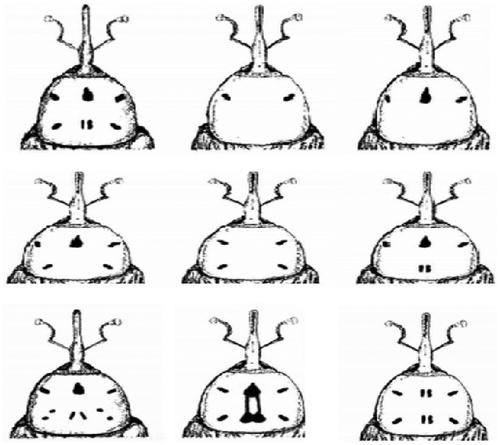Abstract
Rhynchophorus ferrugineus commonly known as Red Palm Weevil is a worldwide distributed and destructive pest of date palm (Phoenix dactylifera) belonging to the family Curculionidae and order Coleoptera. In the present study a total of 365 trees were inspected for Red Palm Weevil infestation in 15 date palm growing areas in district Bannu during September 2013 to June 2014. 500 adults were obtained by capturing alive and dead adult from trees, cocoons and larvae rearing to analyze the size of different body parts and prothoracic black spots and determine the differences and similarities between male and female. Results showed that, 203 trees were infected, and the female was larger in size than the male. Total 13 typologies of prothoracic spots were recorded, among these nine were recorded in both sexes and four only in females. It was concluded that Red Palm Weevil has high diversity worldwide.
Public Interest Statement
The Red palm weevil (Rhynchophorus ferrugineus) is a pest of date palm (Phoenix dactylifera) Which cause a huge damage to the date production. But due to the lack of previous available knowledge and information’s the insect was not considered as of much concern. The district Bannu (Pakistan) is very famous for its date production in the whole country. Due to the tremendous effects of this pest the farmers of this region face a lot of economic loss every year. This paper explores the determinants for farmers in district Bannu (Pakistan) to continuously innovate in part to effectively address the challenges and loss of this pest. This study suggests that Red Palm Weevils are a major concern for the farmers in the study area and further studies are required to understand the exact mechanism of these pests.
Competing interest
The authors declare no competing interest.
1. Introduction
Rhynchophorus ferrugineus commonly known as Red Palm Weevil (RPW) is a pest of date palm (Phoenix dactylifera) belonging to the family Curculionidae and order Coleoptera. The female lay eggs in the axils and petioles of new leaves and in wounds. Larvae burrow into the petioles and reach the terminal bud of date palm and complete their life cycle there (Longo, Citation2006). Larvae construct cocoons from dried fibers where they pupate and then adult emerge from it. Black spots on the adults’ pronotum are due to the presence of melanin in the cuticle while the rusty colour of the weevils is due to the presence of carotenoids in the epidermal cells (Mizzi, Dandria, Mifsud, & Longo, Citation2009).
RPW damage is characterized by: tunnels in the tree from which thick yellow brow fluid oozing out, chewed up fibers in and around the openings of tunnels with fermented odour, production of a gnawing sound by the grubs, cocoons and adults in the leaf axils, fallen empty pupal cases on the ground near the date tree and toppling of the crown in case of severe infestation (Soroker et al., Citation2005).
RPW is found almost throughout the world; native to southern Asia and Melanesia entered the Arabian Gulf countries in the mid-1980s (Bozbuga & Hazir, Citation2008). It reached Eastern Saudi Arabia in 1985 and from there it spread to other countries; first recorded in the Northern United Arab Emirates in 1985, then spread to Oman (Malumphy & Moran, Citation2007). In Iran it was first detected in 1990 and in 2000 it was discovered in Egypt (Ferry & Gomez, Citation2002). It was then found in southern Spain in 1994 and in Israel and Jordan in 1999 (Malumphy & Moran, Citation2007). Reported from Italy in 2004, Canary Islands in 2005, Balearic Islands, Cyprus, France and Greece in 2006, Turkey and Malta in 2007 (Malumphy & Moran, Citation2007; Mizzi et al., Citation2009).
In Date Palm Research Institute, Shah Abdul Latif University, Khairpur during 2009 a study has carried out on RPW. The survey covered 46 orchards of 8 different locations at Khairpur area. The results of the study showed that 219 date palms (5.81%) was infested by RPW (Al-Saoud, Citation2010). 30.4% damage was reported in Italy in 2004 (Conti, Sesto, Raciti, & Tamburino, Citation2008). The attack by RPW would lead to death of date palm tree within 6–8 months (Khiyami & Alyamani, Citation2008). Biological and chemical control of RPW was studied in Sindh, Pakistan (Shahina, Salma, Mehreen, Bhatti, & Tabassum, Citation2009; Shar, Rustmani, & Nizamani, Citation2012). No published work on RPW was found in Khyber Pakhtunkhwa (KPK), so, the current novel work was designed to study the morphological characteristics of RPW in KPK and to assist the future researcher in this field.
2. Material and methods
2.1. Adult collection
In the current study, adults, larvae and cocoons of RPW were collected by various methods from infested date palms in 15 localities in district Bannu, Khyber Pakhtunkhwa, Pakistan during September 2013 to June 2014. Both alive and dead adult RPW were collected by hand picking. During collection 3–5 dead adults were placed in a plastic vial while the live adults were kept individually in the same type of vials provided with date palm slices. Living adults were killed by placing in 10% ethanol solution and then pinned.
2.2. Cocoons collection
Cocoons were collected by hands from date palm plantation as well as from larvae artificial rearing media. The cocoons of both sources were placed in two separate cartons and checked from time to time for adult emergence. The number of emerged adults was noted.
2.3. Larvae collection
Larvae were collected carefully through fine hair brush and reared on the slices of banana stem in plastic container. Container was covered with handkerchief in such a way that air permit and prevent the entry of other insects and kept it at room temperature. When cocoons were originated they were extracted suspiciously and placed and transferred to the specified cocoon rearing carton. The cocoons were checked as repeatedly as possible for adult appearance.
2.4. Identification of male and female Red Palm Weevil
By using the taxonomic work of Shahina et al. differentiation between male and female was made. This was done by checking the tuft of brown hairs on half rostrum of males and absent in females. The adults were used for measuring different body parts using a binocular stereo microscope.
2.5. Morphological differences in adult Red Palm Weevil
Whole body length, abdomen length, abdomen width, pronotum length, pronotum width, head size and length from tip of rostrum to antennal insertion (See Figure ) was studied for morphological differences. The difference in the arrangement of the prothoracic spots in each RPW adult was studied, analyzed and the different typologies encounter was drawn.
3. Results
In total, 500 adult RPW comprising 247 males and 253 females were available for the present study. These were obtained by three methods (i) captured alive or found dead in trees (ii) emerged from cocoons collected from the date palms and (iii) emerged from cocoons formed by reared larvae. 351 weevils were captured alive or found dead in trees. Eight seven adult weevils emerged from 147 cocoons collected from infested palms while 62 adults emerged from 118 cocoons formed by the banana reared larvae (Table ).
Table 1. The number of R. ferrugineus adults collected using different methods
Out of a total of 365 inspected palms from different localities, 203 were found to be infected with the RPW. The date palm trees were inspected for RPW in the following localities of district Bannu: Jhandukhel, MiraKhel, Taji Kala, Ghoriwala, Landidak, Dardarez, Kaski, Mandew, Shahdew, Kakki, Mama Khel, Surrani, Mandan, Mamash Khel and Nurar. The magnitude of the different body parts was measured in the adult RPW of both male (Table and Figure ) and female (Table and Figure ).
Table 2. The Size and length (mm) of different body parts of male RPW
Table 3. Showing the size and length (mm) of different body parts of female RPW
Of the 500 adult weevils which were studied, 13 different typologies of pronotal markings were encountered. Nine typologies were encountered in both males and females (See Figure ), while the four typologies were observed only in females as shown in Figure below. A total of nine typologies was encountered in males and 13 typologies in females.
4. Discussion
Rynchophorus ferrugineous (Olivier), is a polyphagous insect with several host plants, but highly prefer date palms in the entire world. Firstly, it was identified in the early twentieth century in Southern and Southeastern part of Asia. Afterwards, its presence was established in Middle Eastern part of Asia as well as in Northern part of Africa and Europe. By the end of the twentieth century, RPW was spread to Australia. In 2010, it was discovered in Western parts of Northern America. The species was first noted in Malta in 2007 (Cole, Citation2009). The species is a serious pest of date palm trees in Bannu because during current study 40.6% of inspected trees being found infected by RPW. Mizzi et al. (Citation2009) reported 28% infestation rate in Malta.
Only 52% of RPW larvae reared under laboratory conditions on banana managed to reach adult stage. This suggests that many larvae did not survive possibly due to a change in food source which is to be expected since the banana plant is not one of the preferred host plants for the RPW. However, it shows that the RPW is highly adaptable to different diets. It appears that initially larvae find it difficult to survive on the new food source, but those which adapt to it reach the adult stage successfully. According to Mizzi et al. (Citation2009) 40% of larvae reared on banana in laboratory in Malta become an adult. A high mortality rate was also observed when cocoons were reared. Adult weevils managed to emerge from only 59% of cocoons collected in the present study. When Mizzi et al. (Citation2009) rear the collected cocoon then they found 37% cocoon from which adult emerge.
Following conclusions were made from various measurements of body parts of RPW taken in the present study. Total body length, abdominal length, length of the rostrum and length of the rostrum from its apex to antennal insertion was much higher in females RPW than in males. Female appears larger than the male. Such measurements may be used efficiently to distinguish between male and female RPW.
In the present study 500 adults were studied for prothoracic spots. The sample of 77 adults used by Longo (Citation2006) in Sicily and 523 by Mizzi et al. (Citation2009) in Malta for this experiment. Currently, total 13 topologies were reported while Longo (Citation2006) reported 8 typologies in Sicily and 14 were reported by Mizzi et al. (Citation2009) in Malta. Six typologies of the present study are very similar to the typologies recorded in Sicily. The common typologies of current study highly differ from the common typologies reported in Sicily and little differs from that of reported in Malta. The most common typology found currently in RPW was the one exhibiting seven markings. The five-spot typology was the second most common and the two-spot typology was the third most common. Mizzi et al. (Citation2009) reported that the seven-spot typology was most common, followed by the two-spot and then by five-spot typologies in Malta.
5. Conclusion
The current study revealed that the body size was larger in female as compared to male. Different typologies of prothoracic spots were founded in Malta, Sicily and Pakistan (Bannu, Khyber Pakhtunkhwa) which indicates a degree of diversity in Red Palm Weevil population in the World.
Funding
The authors received no direct funding for this research.
Acknowledgments
We bow our heads and fall in prostration before Almighty Allah, who bestowed us with knowledge and wisdom and for under his grace that we live, learn and flourish. We would like to thank all those who assist us during this novel work.
Additional information
Notes on contributors
Asar Khan
Sumaira Shams is the Chairperson and assistant professor at Abdul Wali Khan University Mardan Pakistan. Mr Ijaz ul Haq, Asar Khan & Saima Khan are the MPhil (MS) students conducting their research under Sumaira supervision at the Department of Zoology Abdul Wali Khan University, Pakistan. Her research interests include Applied Entomology, Integrated pest management, Insects of medical and veterinary importance targeting the social economic transformation. Mr Asif Hameed is serving in Department of Zoology, Government Post Graduate College Bannu, Pakistan as lecturer from many years. He is also a trainer and supervisor for Graduate and Undergraduate level studies.
References
- Al-Saoud, A. H. (2010, March). Effect of Red Palm Weevil Rhynchophorus Ferrugineus (Coleoptera: Curculionidae) aggregation pheromone traps’ height and Colors on the number of captured Weevils. In IV International Date Palm Conference 882 (pp. 419–429).
- Bozbuga, R., & Hazir, A. (2008). Pests of the palm (Palmae sp.) and date palm (Phoenix dactylifera) determined in Turkey and evaluation of red palm weevil (Rhynchophorus ferrugineus Olivier) (Coleoptera: Curculionidae). EPPO Bulletin, 38(1), 127–130.10.1111/j.1365-2338.2008.01197.x
- Cole, S. (2009). Insects in Malta, summer 2007. Bulletin of the Amateur Entomologists’ Society, 68(484), 108–112.
- Conti, F., Sesto, F., Raciti, E., & Tamburino, V. (2008). Ecological factors affecting the spread of Rhynchophorus ferrugineus (red palm weevil) in Eastern Sciliy. Palms, 52(3), 127–132.
- Ferry, M., & Gomez, S. (2002). The red palm weevil in the Mediterranean area. PALMS-LAWRENCE-, 46, 172–178.
- Khiyami, M., & Alyamani, E. (2008). Aerobic and facultative anaerobic bacteria from gut of red palm weevil (Rhynchophorus ferrugineus). African Journal of Biotechnology, 7(10), 1432–1437.
- Longo, S. (2006). Verde Urbano-Ulteriori acquisizioni sul Punteruolo rosso asiatico, dannoso alla Palma delle Canarie in Sicilia. Informatore fitopatologico, 56(10), 40.
- Malumphy, C., & Moran, H. (2007). Plant pest notice: Red palm weevil—Rhynchophorus ferrugineus ( No. 50). London: Central Science Laboratory, DEFRA.
- Mizzi, S., Dandria, D., Mifsud, D., & Longo, S. (2009). The Red Palm Weevil, Rhynchophorus ferrugineus (Olivier, 1790) in Malta (Coleoptera: Curculionoidea). Bulletin of the entomological Society of malta, 2, 111–121.
- Shahina, F., Salma, J., Mehreen, G., Bhatti, M. I., & Tabassum, K. A. (2009). Rearing of Rhynchophorus ferrugineus in laboratory and field conditions for carrying out various efficacy studies using EPNs. Pakistan Journal of Nematology, 27(2), 219–228.
- Shar, M. U., Rustmani, M. A., & Nizamani, S. M. (2012). Evaluation of different date palm varieties and pheromone traps against red palm weevil (Rhynchophorus ferrugineus) in Sindh. Journal of Basic and Applied Sciences, 8, 1–5.
- Soroker, V., Blumberg, D., Haberman, A., Hamburger-Rishard, M., Reneh, S., Talebaev, S., … Harari, A. R. (2005). Current status of red palm weevil infestation in date palm plantations in Israel. Phytoparasitica, 33(1), 97–106.10.1007/BF02980931





